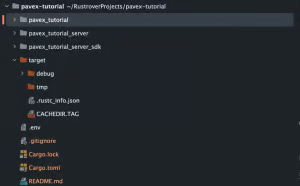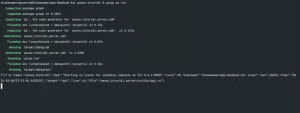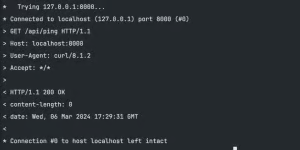Web Development in Rust with Pavex
LogRocket made this piece possible. They provide AI-first session replay and analytics that shows you what's wrong.

There are many web frameworks available for developers to choose from — including more than ten popular web frameworks in the Rust ecosystem. Each Rust framework is opinionated, following the principles and practices of several developers to optimize and ensure they follow great web development methods.
In 2022, Luca Palmieri set out to build the Pavex Rust framework with the aim of achieving great ergonomics, high performance, great usability, and speed on top of the popular Hyper framework. Today, Pavex is in beta and ready to use with these features all coming into play, plus more features like better error messages.
What is Pavex?
Pavex is a new and upcoming Rust framework designed to expand the horizon for Rust web development. It aims to do so by offering a more abstract, ergonomic, and performant development experience.
The Pavex web framework for Rust ensures compile-time safety and better error messaging reducing the learning curve associated with handling compile-time errors and framework overhead. Its architecture is focused on minimizing user-facing content to provide a clean API and developer-friendly approach.
Getting started with Pavex
Since Pavex is Rust-based, you’ll need the Rust toolchain (Rustup and Cargo specifically). Head on to the Rust installation page to install if you don’t have Rust.
You’ll also need to have cargo-px and a cargo subcommand. You can install cargo-px with the directives from its
documentation page.
You’d need to have all these tools available in your PATH, so ensure you do that while installing. You can run this
command to verify your installation.
rustup --version && \\
cargo --version && \\
cargo px --version
Next, you need to install Rust’s nightly toolchain. You can add it to your toolchain with this command:
rustup toolchain install nightly
After installing nightly, add the rust-docs-json component to the build:
rustup component add --toolchain nightly rust-docs-json
Finally, you need to install and activate the Pavex CLI tool. Execute this command to install Pavex:
# shell
curl --proto '=https' --tlsv1.2 -LsSf <https://pavex.dev/releases/download/latest/pavex_cli-installer.sh> | sh
# powershell
irm <https://pavex.dev/releases/download/latest/pavex_cli-installer.ps1> | iex
You can execute this command to verify the installation:
pavex --version
Pavex is in beta, so you need to activate Pavex with an activation key:
pavex self activate
You can retrieve an activation from the Pavex Discord server’s #activation channel after you’ve joined the beta on
Pavex.dev.
Enter the activation key, and then you can proceed to create a new Pavex project with this command:
pavex new pavex-tutorial && cd pavex-tutorial
Open the new Pavex project in your code environment of choice. You should see a folder structure similar to this:

You can proceed to execute a demo Pavex project with this command:
cargo px run
On executing the command, you should get this as output as the server runs on the default port 8080:

You can send a cURL request to the ping the server like so:
curl -v <http://localhost:8000/api/ping>
Here’s the output you should expect:

You need to understand how a Pavex project works to build with the framework. At the core of every Pavex project is
the Blueprint type. You’ll use the Blueprint type to define routes, middleware, error handlers and other functions.
Check the pavex_tutorial/src/blueprint.rs file for the Blueprint of your pavex_tutorial project. Here’s what you
should expect to see:
pub fn blueprint() -> Blueprint {
let mut bp = Blueprint::new();
ApiKit::new().register(&mut bp);
add_telemetry_middleware(&mut bp);
bp
}
The blueprint function contains all the routes, constructors and error handlers. Pavex requires the blueprint
function to run.
Creating your first Pavex route
Routing with Pavex is simple and intuitive compared to many other Rust web frameworks.
You’ll register routes, middleware, etc, in the register function after writing the handler functions like this:
//routes/mod.rs
pub mod status;
pub mod hello;
use pavex::blueprint::{router::GET, Blueprint};
use pavex::f;
pub fn register(bp: &mut Blueprint) {
bp.route(GET, "/api/ping", f!(self::status::ping));
bp.route(GET, "/api/hello/:name", f!(self::hello::hello));
}
Above, we registered the GET request handler function named hello with the /api/hello/:name route. Then, here’s how
you can extract and use path parameters with Pavex:
// routes/hello.rs
use pavex::request::path::PathParams;
use pavex::response::Response;
#[PathParams]
pub struct HelloParameters {
pub name: String,
}
pub fn hello(params: PathParams<HelloParameters>) -> Response {
let HelloParameters { name } = params.0;
Response::ok()
.set_typed_body(format!("Hello, {name}!"))
}
You can use a struct to model the objects you’re expecting from a request. The HelloParameters struct is the struct
for the name parameter from the request. The hello function retrieves the path parameter and writes a string with
the path parameter to the client as a response.
Handling request data with Pavex
Handling request data of all sorts with Pavex is also very intuitive. You can use the serde and serde_json crates
with Pavex for JSON operations. Pavex also provides a JsonBody function for parsing the body of an incoming request as
JSON.
Here’s the full list of imports you’ll need to handle request JSON request data:
use pavex::http::{StatusCode, HeaderValue};
use pavex::request::body::JsonBody;
use pavex::response::Response;
use serde::{Serialize, Deserialize};
use serde_json::to_string;
Next, here’s a User struct for the JSON operation. The #[derive(Serialize, Deserialize)] macro adds serialization
and deserialization functionality via the serde crate:
#[derive(Serialize, Deserialize)]
pub struct User {
pub id: u32,
pub name: String,
pub email: String,
}
Then, here’s how you can deserialize a JSON payload into the User struct:
pub fn create_user(body: JsonBody<User>) -> Response {
let user = body.0; // Deserialization happens here
let saved_user = User { id: 1, ..user };
// other actions
}
The create_user function is a request handler that handles POST requests for creating a new user. It accepts
JSON-encoded data from the request body and deserializes it to retrieve the data in a struct-like manner.
Pavex’s JsonBody<T> extractor deserializes the JSON from the request body.
Here’s how you can register the create_user handler function in the register function.
pub fn register(bp: &mut Blueprint) {
bp.route(POST, "/api/users", f!(self::json::create_user));
}
The create_user function’s functionality is now accessible via the /api/users route, and you can make requests to
it.
Responding to requests
You can respond to client requests using Pavex’s Response object. Here’s how you can implement a GET request handler
function:
use pavex::response::Response;
pub fn get_user() -> Response {
let user = User {
id: 1,
name: "Jane Doe".to_string(),
email: "jane.doe@example.com".to_string(),
};
// Serialize the user struct to a JSON string
match to_string(&user) {
Ok(json) => json,
Err(_) => return Response::new(StatusCode::INTERNAL_SERVER_ERROR),
};
let mut response = Response::new(StatusCode::OK);
response.headers_mut().insert("Content-Type", HeaderValue::from_static("application/json"));
response.body();
response
}
The get_user function creates a User struct instance, serializes the struct to a JSON string and handles associated
errors. Then, it sets the response content type to application/json and writes the serialized struct as a response to
the client.
Using middlewares with Pavex
Pavex middleware simplify adding pre- and post-processing steps to your handler functions. Here’s an example of how you can use middleware in your Pavex projects:
// src/middleware.rs
use pavex::middleware::Next;
use pavex::response::Response;
use std::future::IntoFuture;
pub async fn logging_middleware<C>(next: Next<C>) -> Response
where
C: IntoFuture<Output=Response>,
{
println!("Before handling the request");
let response = next.await;
println!("After handling the request");
response
}
The logging_middleware function uses the Next objects to help with proceeding with the request flow. The function
logs a message before and after execution of the next handler function in the chain.
Here’s an example of how you can register the middleware in the register function:
// routes/mod.rs
pub mod status;
pub mod hello;
pub mod json;
pub mod middleware;
use pavex::blueprint::{router::GET, Blueprint};
use pavex::blueprint::router::POST;
use pavex::f;
pub fn register(bp: &mut Blueprint) {
bp.wrap(f!(self::middleware::logging_middleware));
bp.route(GET, "/api/ping", f!(self::status::ping));
bp.route(GET, "/api/hello/:name", f!(self::hello::hello));
bp.route(POST, "/api/users", f!(self::json::create_user));
bp.route(GET, "/api/users/:id", f!(self::json::get_user));
}
The wrap function register a wrapping middleware. The logging_middleware function now wraps the handler functions
you’ve specified.
Comparing Pavex to existing Rust frameworks
Although it’s new, we’ve seen that Pavex provides most of the features you’ll need in a Rust web framework, including async/await support, middleware, concurrency, and much more.
Pavex is an exciting framework with better documentation, error handling, and semantics than other popular existing web frameworks for Rust. It’s designed for building small- to enterprise-grade applications without trade-offs.
Here’s how Pavex currently compares to the Actix Web, Rocket, Axum, and warp Rust web frameworks:
| Features | Pavex | Actix | Rocket | Axum | warp |
|---|---|---|---|---|---|
| Async/await support | Yes | Yes | Yes | Yes | Yes |
| Middleware | Extensive support with built-in middleware and support for custom middleware | Extensive, with support for custom middleware | Built-in support for various middleware functionalities | Utilizes the tower ecosystem for middleware | Uses filters for middleware-like functionality |
| WebSockets support | No | Comprehensive support | Supported with specific syntax and features | Supported, and integrated with async programming model | Supported, designed for asynchronous communication |
| Concurrency & Performance | Built on Tokio, optimized for async execution | High performance, designed for concurrency | Performance-focused, with specific features for concurrency | Built on Tokio, optimized for async execution | Leverages async execution for performance |
| Cookie and session management | Not yet | Full-featured support | Comprehensive handling capabilities | Through extractors and middleware | Via filters and custom implementations |
| Community and ecosystem | Few beta testers at the moment | Large, with extensive resources | Well-established, with comprehensive documentation | Growing benefits from Tokio ecosystem | Active part of the Tokio ecosystem |
Choosing a Rust web framework should be based on your project’s specifications and needs. You can use this comparison table as a guide to choose a framework after evaluating the project’s specifications.
Conclusion
Pavex is still very new (in closed beta), and before the project is open to the public, you can expect that more features will roll out. However, keep in mind that it’s not meant to be an open source framework — Palmieri intends to add a usage price to the project, although the pricing plan is not yet finalized.
In this article, we learned about the Pavex framework and how you can use it for Rust web development. Pavex is an exciting project for many Rust devs especially in terms of the fact that it improves on the functionality of many existing frameworks. It has great development experience — you should try it out when it’s live.